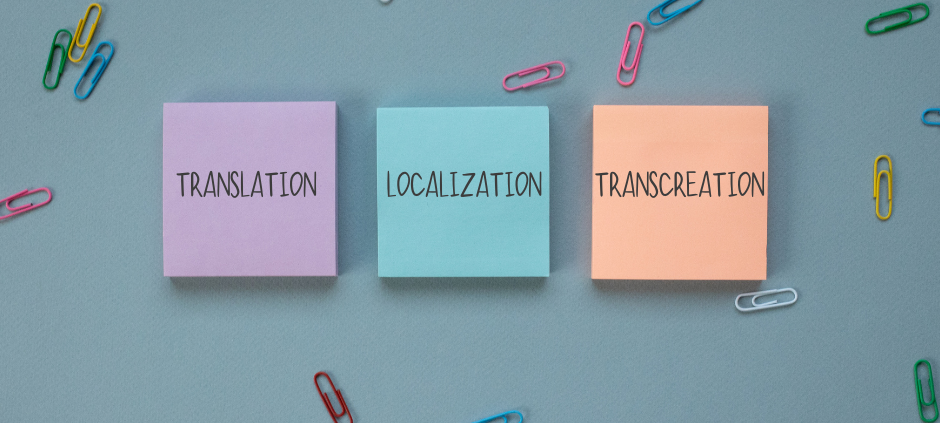What’s the Difference Between Translation, Localization and Transcreation?
The language service sector is vast and complex. Professionals in this industry provide more than just translation services. You’ve probably heard the terms localization and transcreation. But do you know the difference between them? Let’s take a deeper look.
What do translation, localization and transcreation involve?
We need to define what we mean by translation, localization and transcreation before looking at how they differ.
What is translation?
Translation involves translating a document from a source language (U.S. English, for example) to a target language (French from France, for example). The goal is to make the document available in another language for a specific audience.
It’s about conveying a message, idea or story. For example, literary translation involves taking the emotion and world of a story from one language into another. The author’s style needs to be replicated in the other language as naturally as possible.
The most basic type of translation involves an informative document such as a contract, legal document or user manual. The communication goal in this case is for the audience to understand the text and be able to use it, rather than to be motivational. Some documents may be intended for publication, while others will only be used internally at a particular organization.
In any case, the translation must be natural, no matter the type of document. That’s why professional translators work exclusively from their native language into a target language. For example, there’s no one better to translate into U.S. English than a native U.S. English speaker.
There are numerous areas of specialization. Examples include medical translation, legal translation and technical translation. Ready to get started on a translation project? Contact our sales team to request a quote.
What is localization in translation?
Localization also involves translating a text from a source language into a target language, along with adapting cultural aspects to fit the target market.
These aspects can include units of measurement, currencies and specific cultural references. For example, France uses the metric system. The United States uses the Imperial system, while other English-speaking countries use a combination of the two. So, the localization of a U.S. text that references pounds (Imperial system) would instead use the kilogram (metric system).
Products that can be localized include a website, a software system or an app. The goal is to adapt this product to a given target market. Companies may want to conduct a market study to determine whether a product will perform well in a new market.
Do you have content or a website to localize? Contact us to talk about your project!
What is transcreation?
Transcreation is more complex than translation or localization. It goes well beyond translation, because it involves writing new content based on a source text.
The translator will move away from the source language to create a text that is perfectly adapted to the target culture. Strong writing abilities and target culture knowledge are more important here than translation skills.
Transcreation is often used for marketing translation projects. Examples include adapting a tagline or an ad campaign.
Kristy Brown Lust, a translator on our internal team, recently presented a webinar on this topic: How Transcreation Can Help Your Business. Click on the image below to watch the replay.
What’s the difference between these services?
Now that you have a basic understanding of these services, let’s go deeper and review their differences. This section will help you choose the right service for your project.
What’s the difference between translation and localization?
A translation may not require adapting cultural aspects.
For example, for a translation from U.S. English into French from France, a linguist may choose to keep the units of measurement in the Imperial system as written in the English source. However, if the project needs to be localized, the methodology will include converting the measurements from the Imperial to the metric system. In some cases, a translator’s note will be added to the bottom of the document to explain this choice.
What’s the difference between translation and transcreation?
Translation doesn’t necessarily require adapting a text or following a client brief.
In contrast, a transcreator evaluates the entire document and identifies the information that is most relevant to convey the intended message to the target audience, based on the client brief. Some information may be removed or presented in a different way. A translator will translate the document without necessarily changing the order of the information or adapting it. A transcreator may also adapt cultural references that the target audience wouldn’t understand, like an event in Quebec that doesn’t occur in France. The translator may choose to leave the reference from the source language as-is or add an explanation in parentheses.
What’s the difference between localization and transcreation?
Localization adapts a product (like a website, a software system or an app) and its technical characteristics, while transcreation adapts the text and its message (like a slogan or marketing campaign). These are two distinct services.
The ITC Translations team is here to provide support and advice. Check out our pages on the various services and contact us to get more details and help choosing the best service to fulfill your communication goals.
















Leave a Reply
Want to join the discussion?Feel free to contribute!